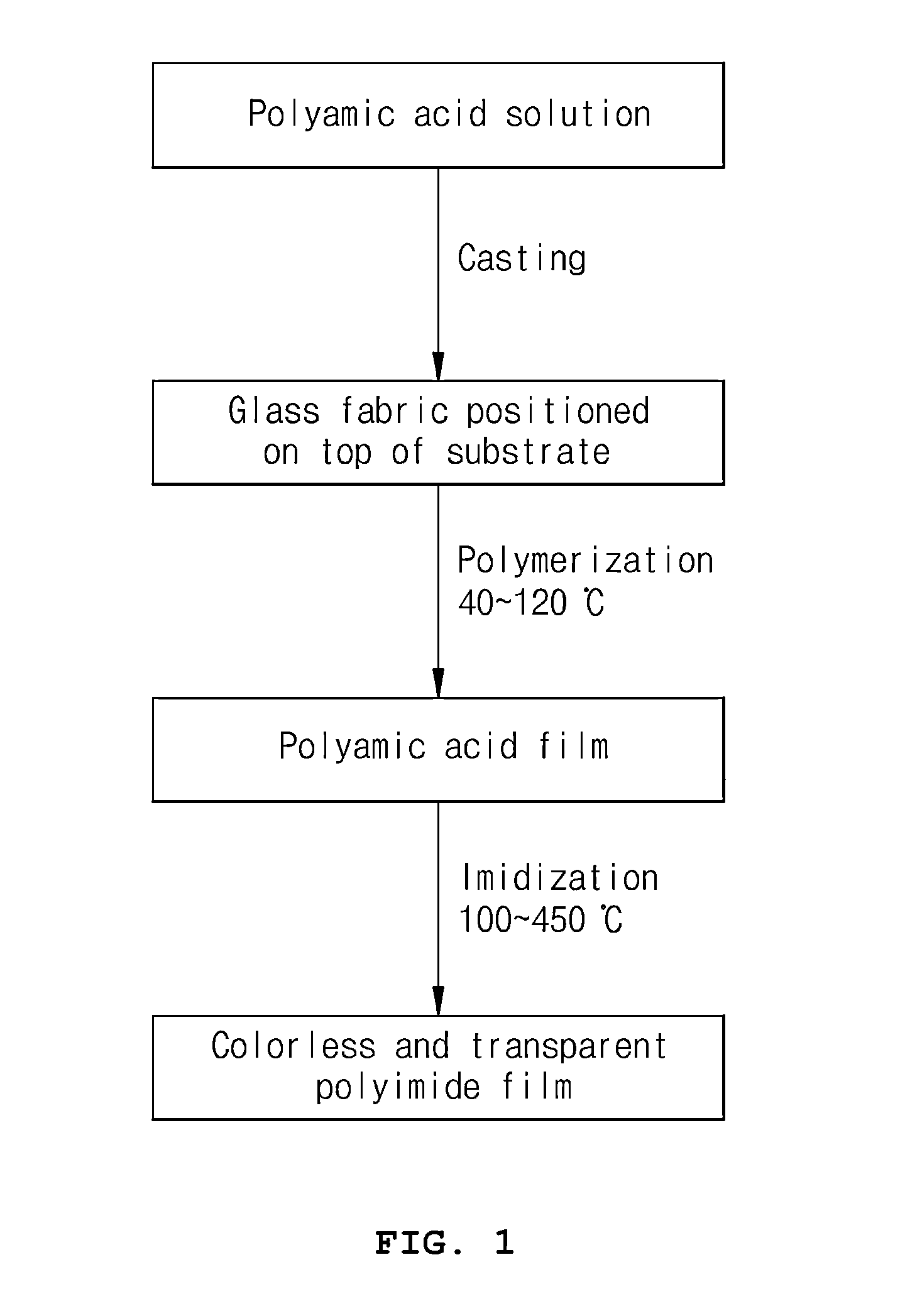Method for manufacturing colorless transparent glass-fabric reinforced polyimide film for flexible displays
a technology of colorless transparent glass and flexible displays, applied in the direction of instruments, synthetic resin layered products, optical elements, etc., can solve the problems of substrate becoming optically opaque, plastic film substrates with significantly higher mechanical flexibility but inferior tensile strength compared with glass substrates, and substrates with thermal and mechanical properties limited by thin glass plates and stainless steel plates, etc., to achieve high optical transparency and optical transmittance, enhance the thermal and mechanical properties of substrates
- Summary
- Abstract
- Description
- Claims
- Application Information
AI Technical Summary
Benefits of technology
Problems solved by technology
Method used
Image
Examples
example 1
[0053]2.31 g (5.2×10−3 mol) of 4,4′-(hexafluoroisopropylidene)diphthalic anhydride (6FDA) as a dianhydride monomer and 1.29 g (5.2×10−3 mol) of bis(3-aminophenyl)sulfone (APS) as a diamine monomer were added to 26.99 g of a dimethyl acetamide (DMAc) solvent, and these monomers were completely dissolved with slow stirring using a magnetic stirrer in a nitrogen atmosphere at 0° C. for 1 hr, and the resulting solution was polymerized with vigorous stirring at room temperature (25° C.) for 15 hr or more, thus preparing a polyamic acid solution (PAA-1). Separately, 5.47 g (1.231×10−2 mol) of 6FDA as a dianhydride monomer and 4.46 g (1.231×10−2 mol) of 2,2-bis(3-amino-4-methylphenyl)hexafluoropropane (BAMF) were added to 74.44 g of DMAc, and then treated in the same manner as above, thus preparing a polyamic acid solution (PAA-2). The polyamic acid solutions PAA-1 and PAA-2 were blended at a weight ratio of 4:6 (5.96 g:8.94 g), thus obtaining a blended polyamic acid solution.
[0054]To mini...
example 2
[0058]5.33 g (1.2×10−2 mol) of 4,4′-(hexafluoroisopropylidene)diphthalic anhydride (6FDA) as a dianhydride monomer, and as diamine monomers, 1.3 g (5.244×10−3 mol) of bis(3-aminophenyl)sulfone (APS) and 2.45 g (6.756×10−3 mol) of 2,2-bis(3-amino-4-methylphenyl)hexafluoropropane (BAMF) were added to 68.07 g of DMAc, and these monomers were completely dissolved with slow stirring using a magnetic stirrer in a nitrogen atmosphere at 0° C. for 1 hr, and the resulting solution was copolymerized with vigorous stirring at room temperature (25° C.) for 15 hr or more, thus preparing a polyamic acid solution.
[0059]To minimize generation of bubbles in a film forming process, the pressure inside the flask containing the polyamic acid solution was reduced by means of an aspirator, so that dissolved oxygen or micro-bubbles were thoroughly removed from the solution.
[0060]Glass fabric having an area of 95×95 mm2 and a thickness of 25 μm was placed on a glass substrate having an area of 100×100 mm2 ...
example 3
[0063]6.22 g (1.2×10−2 mol) of 2,2-bis[4-(4-aminophenoxy)phenyl]hexafluoropropane (6FBAPP) as a diamine monomer, and as dianhydride monomers, 0.69 g (2.796×10−3 mol) of bicycle[2.2.2]oct-7-ene-2,3,5,6-tetracarboxylic dianhydride (BCDA) and 2.06 g (9.204×10−3 mol) of 1,2,4,5-cyclohexanetetracarboxylic dianhydride (CHDA) were added to 67.24 g of DMAc, and these monomers were completely dissolved with slow stirring using a magnetic stirrer in a nitrogen atmosphere at 0° C. for 1 hr, and the resulting solution was copolymerized with vigorous stirring at room temperature (25° C.) for 15 hr or more, thus preparing a polyamic acid solution.
[0064]To minimize generation of bubbles in a film forming process, the pressure inside the flask containing the polyamic acid solution was reduced by means of an aspirator, so that dissolved oxygen or micro-bubbles were thoroughly removed from the solution.
[0065]Glass fabric having an area of 95×95 mm2 and a thickness of 25 μm was placed on a glass subst...
PUM
| Property | Measurement | Unit |
|---|---|---|
| Temperature | aaaaa | aaaaa |
| Temperature | aaaaa | aaaaa |
| Temperature | aaaaa | aaaaa |
Abstract
Description
Claims
Application Information
 Login to View More
Login to View More - R&D
- Intellectual Property
- Life Sciences
- Materials
- Tech Scout
- Unparalleled Data Quality
- Higher Quality Content
- 60% Fewer Hallucinations
Browse by: Latest US Patents, China's latest patents, Technical Efficacy Thesaurus, Application Domain, Technology Topic, Popular Technical Reports.
© 2025 PatSnap. All rights reserved.Legal|Privacy policy|Modern Slavery Act Transparency Statement|Sitemap|About US| Contact US: help@patsnap.com



